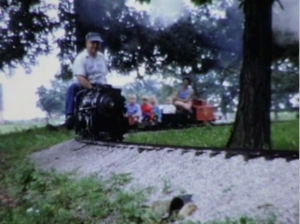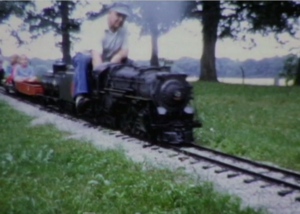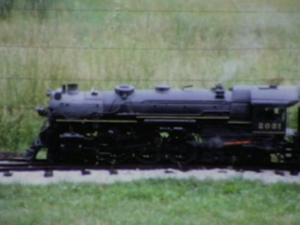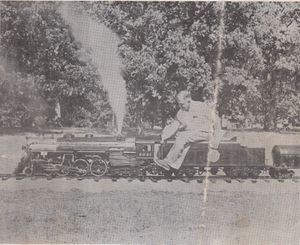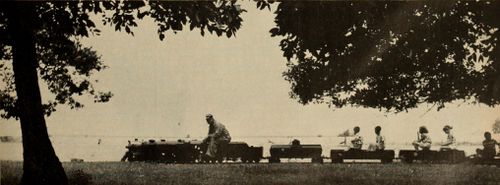Walter Johnston: Difference between revisions
No edit summary |
No edit summary |
||
| Line 15: | Line 15: | ||
: Walter Johnston had quite a railroad on a farm. It was just across the border from Chicago in Indiana. My diesel was the first diesel to run on his track. He later came to visit me in Homestead, Florida and ran my diesel there. I don't know what may have happened to his track. It was on property that his relative [[Emery Ohlenkamp]] (the injector manufacturer) owned. | : Walter Johnston had quite a railroad on a farm. It was just across the border from Chicago in Indiana. My diesel was the first diesel to run on his track. He later came to visit me in Homestead, Florida and ran my diesel there. I don't know what may have happened to his track. It was on property that his relative [[Emery Ohlenkamp]] (the injector manufacturer) owned. | ||
== Hobbies, Unlimited! == | |||
The following article appeared in the magazine <i>Together</i>, January 1959. | |||
[[File:WalterSJohnston Railroad Together magazine January1959.JPG|thumb|center|500px|It really runs on steam, this remarkable exact-scale train built by hobbyist Walter Johnston. That's Walt operating the engine.]] | |||
YOU COULD HARDLY call it a "model" train. The engine is one eighth full size, weighs 1,440 pounds, and runs on live steam supplied by a coal-burning boiler. And the eight cars it tows carry up to 20 passengers. | |||
But one thing is clear: this unusual product of a home workshop marks [[Walter Johnston|Walter S. Johnston]] as a true railroader at heart — even though he's a manufacturing-plant manager by profession. It's the culmination of a hobby interest that began years ago when this locomotive engineer's son first yearned to have a real whistle-tooting, smoke-belching locomotive. That dream has come true only in the past 15 years, during which he has built two live-steam engines — and, for the larger, more recent one, three gondola cars, three flat cars, a tank car, and a caboose. Soon he'll add four new boxcars. | |||
The pride of the "Johnston Line" is the 12-foot locomotive and tender, an exact-scale replica (1-1/2 inch per foot) of a New York Central Hudson-type engine. Mr. Johnston designed, manufactured, and assembled it almost entirely in his well-equipped basement shop. He needed technical knowledge of steam locomotive operation, machine design, pattern making, etc. — and plenty of patience, stretched over six years and roughly 3,000 man-hours. When the engine finally was completed, he excitedly fired it up right in his shop. Smoke and steam soon had him gasping for air, and big drops of condensation hung from the ceiling. But, says Mrs. Johnston, the look on his face when the engine worked was well worth the expense of redecorating! | |||
The complete 10-section train is far too big for the usual back yard. So Mr. Johnston laid nearly a half mile of special 7-1/2 inch track on a friend's Indiana farm. When summer comes, the train is moved 30 miles to the farm from its off-season "roundhouse" — the Johnston home in Blue Island, 111. | |||
Once it is on the tracks, Mr. Johnston dons overalls and an engineer's cap to fuel the tender with coal and water, fire up the boiler, oil running gear, and fill lubricators. Then, with a shriek of the whistle, a few huffs of black smoke, and a rush of live steam, the train is under way. Soon the click of wheels indicates 80 miles | |||
an hour — scale speed. The train brakes to descend a grade, rounds a curve, then climbs uphill with the sharp bark of its steam exhaust echoing across the fields. | |||
Up front, astride the engine, Engineer Johnston again breathes the delicious lingering aroma of steam, valve oil, and coal smoke. Sure, he knows diesels are more powerful and more economical than an old-fashioned steam engine. But the <i>Johnston Line</i> is strictly for pleasure — and that's a dividend it pays every year! | |||
— Richard C. Underwood | |||
== References == | == References == | ||
* <i>The Miniature Locomotive</i> magazine, March-April 1953 | * <i>The Miniature Locomotive</i> magazine, March-April 1953 | ||
Revision as of 21:25, 14 June 2017
Walter Johnston was a Chicago-area live steamer.
Walter Johnston at his track in Indiana, just outside of Chicago, Ill. From video of Bill Koster, about 1970.
Walter S. Johnston and his No. 2031. She is 1-1/2 inch scale, 7-1/2 inch gauge and weighs 1440 pounds dry. She is the motive power for the Johnston Line, a 2000 foot pike having many curves and heavy grades. Train equipment consists of 3 flat cars, 3 gondolas, a tank car and caboose. Three more cars are under construction. From The North American Live Steamer, Number 1 Volume 9, 1956.
Bill Koster wrote:
- Walter Johnston had quite a railroad on a farm. It was just across the border from Chicago in Indiana. My diesel was the first diesel to run on his track. He later came to visit me in Homestead, Florida and ran my diesel there. I don't know what may have happened to his track. It was on property that his relative Emery Ohlenkamp (the injector manufacturer) owned.
Hobbies, Unlimited!
The following article appeared in the magazine Together, January 1959.
YOU COULD HARDLY call it a "model" train. The engine is one eighth full size, weighs 1,440 pounds, and runs on live steam supplied by a coal-burning boiler. And the eight cars it tows carry up to 20 passengers.
But one thing is clear: this unusual product of a home workshop marks Walter S. Johnston as a true railroader at heart — even though he's a manufacturing-plant manager by profession. It's the culmination of a hobby interest that began years ago when this locomotive engineer's son first yearned to have a real whistle-tooting, smoke-belching locomotive. That dream has come true only in the past 15 years, during which he has built two live-steam engines — and, for the larger, more recent one, three gondola cars, three flat cars, a tank car, and a caboose. Soon he'll add four new boxcars.
The pride of the "Johnston Line" is the 12-foot locomotive and tender, an exact-scale replica (1-1/2 inch per foot) of a New York Central Hudson-type engine. Mr. Johnston designed, manufactured, and assembled it almost entirely in his well-equipped basement shop. He needed technical knowledge of steam locomotive operation, machine design, pattern making, etc. — and plenty of patience, stretched over six years and roughly 3,000 man-hours. When the engine finally was completed, he excitedly fired it up right in his shop. Smoke and steam soon had him gasping for air, and big drops of condensation hung from the ceiling. But, says Mrs. Johnston, the look on his face when the engine worked was well worth the expense of redecorating!
The complete 10-section train is far too big for the usual back yard. So Mr. Johnston laid nearly a half mile of special 7-1/2 inch track on a friend's Indiana farm. When summer comes, the train is moved 30 miles to the farm from its off-season "roundhouse" — the Johnston home in Blue Island, 111.
Once it is on the tracks, Mr. Johnston dons overalls and an engineer's cap to fuel the tender with coal and water, fire up the boiler, oil running gear, and fill lubricators. Then, with a shriek of the whistle, a few huffs of black smoke, and a rush of live steam, the train is under way. Soon the click of wheels indicates 80 miles an hour — scale speed. The train brakes to descend a grade, rounds a curve, then climbs uphill with the sharp bark of its steam exhaust echoing across the fields.
Up front, astride the engine, Engineer Johnston again breathes the delicious lingering aroma of steam, valve oil, and coal smoke. Sure, he knows diesels are more powerful and more economical than an old-fashioned steam engine. But the Johnston Line is strictly for pleasure — and that's a dividend it pays every year!
— Richard C. Underwood
References
- The Miniature Locomotive magazine, March-April 1953

